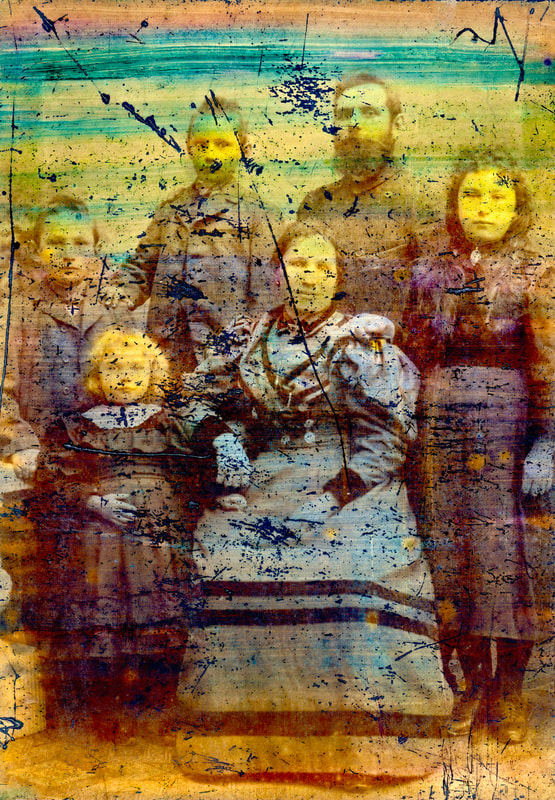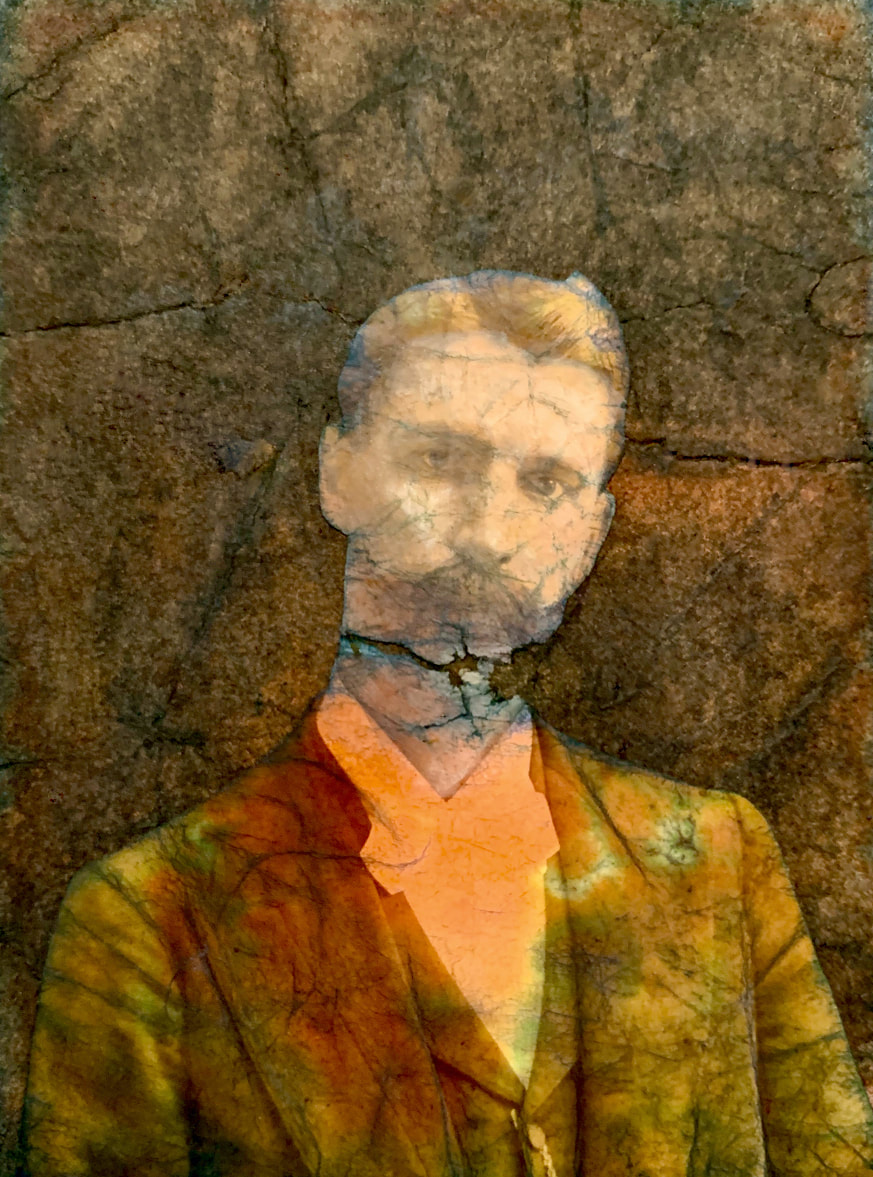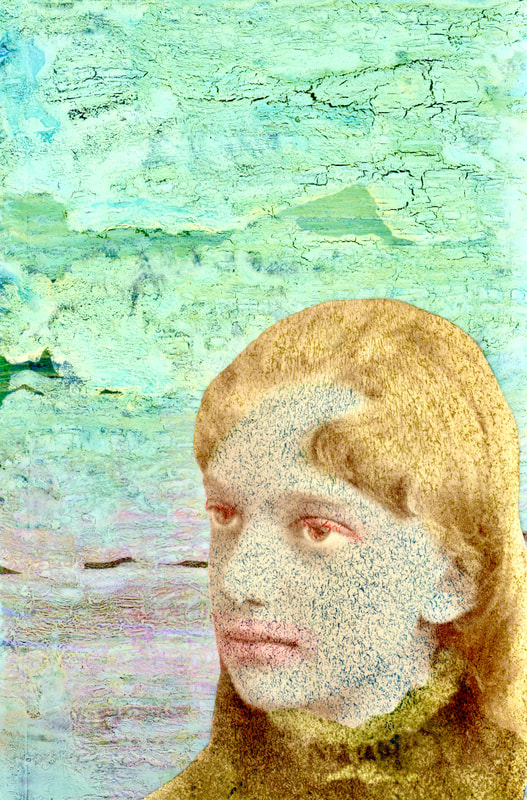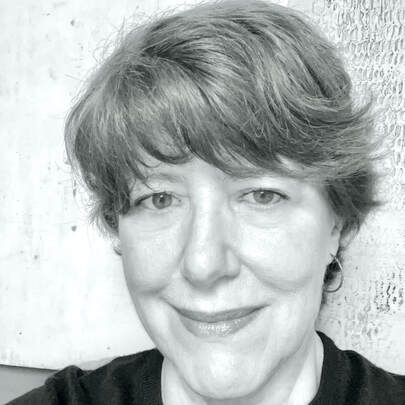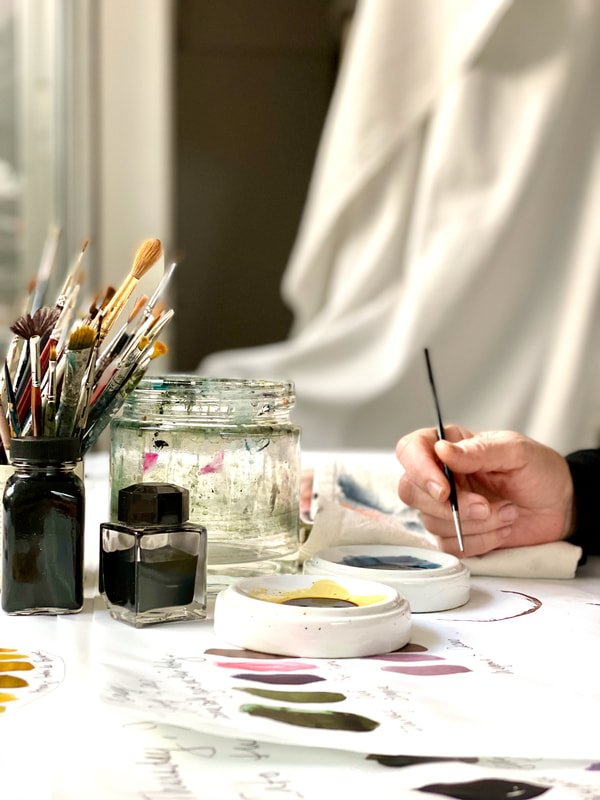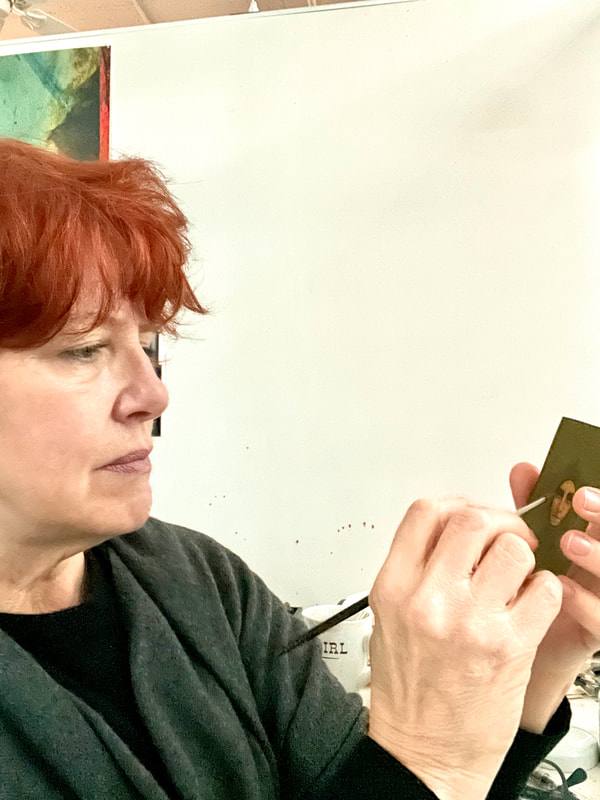In her work, artist Julie Blankenship explores and describes the ephemeral nature of objects and the changeable nature of identity. She is known for her photo-based, mixed media work using found photographs, that she processes and alters with ink, dust and glue.
She taught at the San Francisco Art Institute (her alma mater) and San Francisco State University’s Inter-Arts Center. Blankenship was Executive Director of Visual Aid, an arts/social justice organization serving artists with AIDS, where she opened Visual Aid Gallery.
Her work has appeared in many publications including Poets & Writers Magazine, Kolaj Magazine, High Shelf Press, and Museum of Americana Literary Review in the United States; Blood Bath, London Reader, Sein und Werden, Foxhole, and Egeaus Press in the United Kingdom. Interviews are featured in the film Mrs. Vera’s Daybook and on Spark* KQED Arts.
Blankenship’s exhibitions have included solo shows/projects at Amsterdams Centrum voor Fotografie in Amsterdam, American Institute of Architects Architecture+Design Gallery and Joseph Chowning Gallery; and installations at the San Francisco Arts Commission, and The Lab Gallery in the Bay Area. Her work has been featured in group shows at numerous venues including Kirkby Gallery in Liverpool, CICA Museum in Seoul, Centrum Beeldende Kunst in Hoorn, Netherlands, CheapFest in Bologna; Walter and McBean Gallery, Collision Gallery, Heller Gallery, a.Muse Gallery and Camerawork in the San Francisco. She has been involved with collaborative projects including Silent Fire, presented by Yale University Institute of Sacred Music and Nasty Women Connecticut; and Telephone.
She taught at the San Francisco Art Institute (her alma mater) and San Francisco State University’s Inter-Arts Center. Blankenship was Executive Director of Visual Aid, an arts/social justice organization serving artists with AIDS, where she opened Visual Aid Gallery.
Her work has appeared in many publications including Poets & Writers Magazine, Kolaj Magazine, High Shelf Press, and Museum of Americana Literary Review in the United States; Blood Bath, London Reader, Sein und Werden, Foxhole, and Egeaus Press in the United Kingdom. Interviews are featured in the film Mrs. Vera’s Daybook and on Spark* KQED Arts.
Blankenship’s exhibitions have included solo shows/projects at Amsterdams Centrum voor Fotografie in Amsterdam, American Institute of Architects Architecture+Design Gallery and Joseph Chowning Gallery; and installations at the San Francisco Arts Commission, and The Lab Gallery in the Bay Area. Her work has been featured in group shows at numerous venues including Kirkby Gallery in Liverpool, CICA Museum in Seoul, Centrum Beeldende Kunst in Hoorn, Netherlands, CheapFest in Bologna; Walter and McBean Gallery, Collision Gallery, Heller Gallery, a.Muse Gallery and Camerawork in the San Francisco. She has been involved with collaborative projects including Silent Fire, presented by Yale University Institute of Sacred Music and Nasty Women Connecticut; and Telephone.
Published on March 14th, 2022. Artist responses collected in months previous.
What are you currently excited about in your art practice?
I’m excited about developing an exhibition with my friend, new media artist Paula Levine, who I’ve known for over thirty-five years. During the time of Covid, we’ve forged a stronger bond and have been meeting over zoom to talk about our work, problem solve, encourage and support each other’s processes. Although different in style and appearance, all of our work explores themes related to identity, time, death, history, repetition, archives--the presence of absence and the absence of presence. We’re able to offer each other new perspectives, which is incredibly helpful. The exhibition will be synergistic, talking about our relationship, and the relationship between our work, as well as the work itself.
What were some of the challenges you faced last year as an artist? Was your work/ art practice affected by the pandemic this year, if so how?
I am weary, and like everyone else, tired of thinking about Covid, and Covid precautions. It’s had a dampening effect on my work and creativity. Although I’m an introvert and comfortable being alone, I crave the stimulation of studio visits, galleries and museums, in-person classes, and long, open-ended conversations with artists and friends. This year, I volunteered (remotely) with the San Francisco Art Institute, created a group to promote communication, worked on an art auction fundraiser and threw a party on campus for students and staff--the first since Covid that alumni were able to do anything on campus. Volunteering has helped me retain my sanity and connection with other artists.
What does a typical day in the studio (or wherever you're making work) look like for you these days? What time of day are you at your studio, what are your studio must haves (ex: music, coffee, tools, etc), and what does your creative space look like?
My studio is on the third floor of an old industrial building that was once a Sears department store, located in La Lengua, a tongue-shaped area on the southernmost edge of the Mission District. With no heat or air circulation, the building is searingly hot in the summer and terribly cold in the winter. I run a small, group studio, and have 3-4 other studios adjacent to mine, where other artists work. My own studio is located on a corner between two interior atriums, and beautiful indirect light comes in through the windows, most of the year. I live nearby, and walk over to my studio in the afternoon. When I arrive, after making myself a mug of green tea (and in winter, piling on extra layers of clothing), I fire up my iPad and listen to an audio book or podcast--speculative fiction (Sherd’s is a favorite), Victorian literature or true crime. I cover my table with clean paper, where I record the date, and, as I work, inks, formulas for color mixtures, and notes. Then I decide where to start, and work for 4 or 5 hours.
What resources for artists have you found helpful that may be helpful for other artists?
In planning to publish a website, I’ve been looking at various platforms, and am thinking of going with Other People’s Pixels. It’s specifically a portfolio website for artists, run by artists—rather than something created by people who have no idea what artists want or need. Buymeacoffee is a crowdsourcing platform, based in San Francisco, that’s a way for creatives to receive donations in a simple format. I frequently visit both large and obscure sites with calls for artists for publications and exhibitions, such as Duotrope, Hyperallergic, SPE, Submittable, CAA, Artenda and many others. I’d be happy to make suggestions for individual artists, and possibly point them in a direction they’re interested in. Artists are welcome to message me through my Instagram, @privateyesf.
What in your art career are you looking forward to in the upcoming year? Do you have any specific goals or projects in mind?
I have a lot of work ahead of me this year. I’ve just begun a new series of work, altering found images to focus the viewer’s attention on small details of the human body, then building grids of the images for an installation. For the very first time, this year I’ll have access to the equipment needed to make high-level scans and prints of my work. By necessity, I’ll learn to print and will begin making editions of prints for portfolios or books. Figuring out how best to present my work for exhibition has been challenging. I look forward to exploring different sizes and unusual formats, such as printing large-scale on silk or aluminum. I’ll be researching spaces or galleries that are good matches for my work, and will continue to submit work for publication. And I commit to putting up a website in 2022.
What are you currently excited about in your art practice?
I’m excited about developing an exhibition with my friend, new media artist Paula Levine, who I’ve known for over thirty-five years. During the time of Covid, we’ve forged a stronger bond and have been meeting over zoom to talk about our work, problem solve, encourage and support each other’s processes. Although different in style and appearance, all of our work explores themes related to identity, time, death, history, repetition, archives--the presence of absence and the absence of presence. We’re able to offer each other new perspectives, which is incredibly helpful. The exhibition will be synergistic, talking about our relationship, and the relationship between our work, as well as the work itself.
What were some of the challenges you faced last year as an artist? Was your work/ art practice affected by the pandemic this year, if so how?
I am weary, and like everyone else, tired of thinking about Covid, and Covid precautions. It’s had a dampening effect on my work and creativity. Although I’m an introvert and comfortable being alone, I crave the stimulation of studio visits, galleries and museums, in-person classes, and long, open-ended conversations with artists and friends. This year, I volunteered (remotely) with the San Francisco Art Institute, created a group to promote communication, worked on an art auction fundraiser and threw a party on campus for students and staff--the first since Covid that alumni were able to do anything on campus. Volunteering has helped me retain my sanity and connection with other artists.
What does a typical day in the studio (or wherever you're making work) look like for you these days? What time of day are you at your studio, what are your studio must haves (ex: music, coffee, tools, etc), and what does your creative space look like?
My studio is on the third floor of an old industrial building that was once a Sears department store, located in La Lengua, a tongue-shaped area on the southernmost edge of the Mission District. With no heat or air circulation, the building is searingly hot in the summer and terribly cold in the winter. I run a small, group studio, and have 3-4 other studios adjacent to mine, where other artists work. My own studio is located on a corner between two interior atriums, and beautiful indirect light comes in through the windows, most of the year. I live nearby, and walk over to my studio in the afternoon. When I arrive, after making myself a mug of green tea (and in winter, piling on extra layers of clothing), I fire up my iPad and listen to an audio book or podcast--speculative fiction (Sherd’s is a favorite), Victorian literature or true crime. I cover my table with clean paper, where I record the date, and, as I work, inks, formulas for color mixtures, and notes. Then I decide where to start, and work for 4 or 5 hours.
What resources for artists have you found helpful that may be helpful for other artists?
In planning to publish a website, I’ve been looking at various platforms, and am thinking of going with Other People’s Pixels. It’s specifically a portfolio website for artists, run by artists—rather than something created by people who have no idea what artists want or need. Buymeacoffee is a crowdsourcing platform, based in San Francisco, that’s a way for creatives to receive donations in a simple format. I frequently visit both large and obscure sites with calls for artists for publications and exhibitions, such as Duotrope, Hyperallergic, SPE, Submittable, CAA, Artenda and many others. I’d be happy to make suggestions for individual artists, and possibly point them in a direction they’re interested in. Artists are welcome to message me through my Instagram, @privateyesf.
What in your art career are you looking forward to in the upcoming year? Do you have any specific goals or projects in mind?
I have a lot of work ahead of me this year. I’ve just begun a new series of work, altering found images to focus the viewer’s attention on small details of the human body, then building grids of the images for an installation. For the very first time, this year I’ll have access to the equipment needed to make high-level scans and prints of my work. By necessity, I’ll learn to print and will begin making editions of prints for portfolios or books. Figuring out how best to present my work for exhibition has been challenging. I look forward to exploring different sizes and unusual formats, such as printing large-scale on silk or aluminum. I’ll be researching spaces or galleries that are good matches for my work, and will continue to submit work for publication. And I commit to putting up a website in 2022.
Find Julie Blankenship on Instagram
